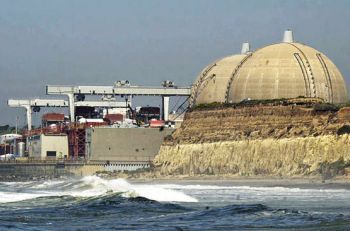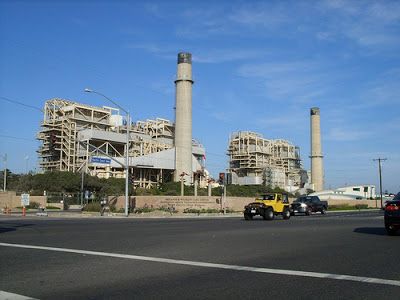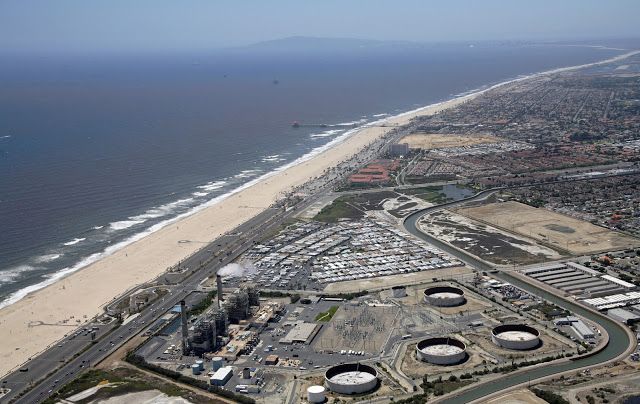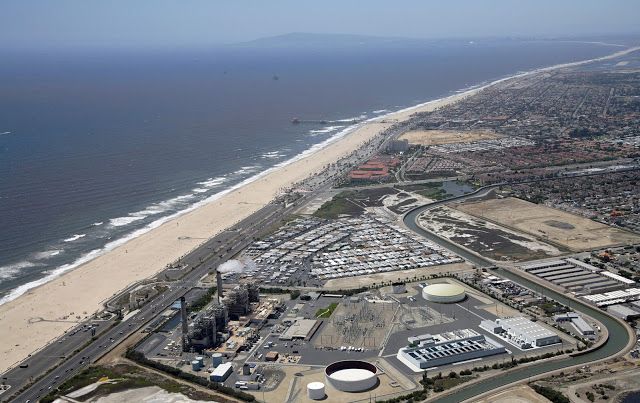
Publisher:
Bonnie King
CONTACT:
Newsroom@Salem-news.com
Advertising:
Adsales@Salem-news.com

~Truth~
~Justice~
~Peace~
TJP
Jun-21-2013 10:41

 TweetFollow @OregonNews
TweetFollow @OregonNews
San Onofre Nuclear Generating Station (SONGS): Closure Has Ocean Desalination Ramifications
Roger E. Bütow Odd Man Out Salem-News.comSo Cal Edison permanent closure in San Clemente might have far-reaching implications for other projects in California, including the Poseidon Huntington Beach Seawater Desalination Facility in Orange County.
 Courtesy: prwatch.org |
(LAGUNA BEACH) - The announcement by Southern California Edison (SCE) regarding SONGS led to this recent headline:
“San Onofre closure will remake local power grid, PUC chief says…” by Abby Sewell LA Times June 11, 2013
http://www.latimes.com/local/lanow/la-me-ln-san-onofre-cpuc-chair-20130611,0,3189452.story?track=rss
Statements made by the California Public Utilities Commission (CPUC) to the Times hint at possible multiple game changers regarding controversial “Once-Through-Cooling” (OTC) at power grid facilities.
The natural gas powered, AES-operated Huntington Beach plant that supplies SCE customers brought two (2) dormant, once-retired units back online last year to offset the SONGS being offline, and that’s where it starts getting intriguing.
It has a total of 4 generators onsite. Retooling and then rebooting those 2 steam turbines has made a difference between brownouts or outages locally. Disruption of many energy-reliant facilities like groundwater pumping for potable delivery, waste transport/pumping systems plus waste-into-drinking water treatment plants for extended periods would be catastrophic, not to mention create potentially communicable, epidemic health conditions.
“California finds backup power for offline San Onofre nuclear plant in Huntington Beach” by Ed Joyce June 20, 2012
http://www.scpr.org/news/2012/06/20/32905/backup-electricity-found-offline-san-onofre-nuclea/
As summer of 2013 approaches, these 2 units will supply about 400,000 homes in the greater OC, and online sources claim that’s about 25% of the energy formerly provided by SONGS.
 AES Operated Generating Station in Huntington Beach |
For a master list of OTC plants and locations on the State Water Resources Control Board (SWRCB) decommissioning or significant alteration candidates, go to this link, there’s probably one near you:
http://www.waterboards.ca.gov/water_issues/programs/ocean/cwa316/powerplants/
OTC was headed for significant modification/alterations or outright prohibition when individual, existing outfall discharge permits (NPDES) expire, with probably no new installations availing themselves of OTC.
And here’s where it gets a lot more interesting. Now the CPUC has signaled that everything is back on the table: Including existing OTC installations like the one in Huntington Beach where Poseidon hopes to “co-locate” a large ocean desalination plant.
The plant will provide 50 million gallons per day (50 mgd) of much needed drinking water for Orange County delivery agencies. It’s estimated to provide about 8% of our potable (drinking water) requisites, but it will only supplement or compliment and will not 100% replace existing sources. Increased wastewater reclamation and groundwater recovery systems will make a big dent too. There’s no one source, never was, never will be.
 AES Huntington Beach (left) site for proposed Poseidon Seawater Desalination today |
The plants would not only need very expensive and technically complex, state of the art upgrades, advanced tertiary as it’s known, but a lot more land would need to be purchased for such massive, monolithic installations.
The ocean outfall discharge infrastructure and required permits by EPA in South OC could be very problematic. Not only would these pipes, buried far out into the Pacific need recalibrating, that is replaced or rebuilt to larger capacity due to increased volumes, but the increased pollutant loading from advanced reclamation would have adverse impacts that couldn't be mitigated very easily---if at all. EPA monitors and limits such discharges under their NPDES Permit process. That's a crap shoot with unknown endgame.
Since the odors in wastewater treatment and reclamation aren’t all that pleasing, South OC neighbors near such projects will come out of the woodwork. This has already happened at the South OC Wastewater Authority in Dana Point. Expansion or increased usage is met with lawsuits.
Not all of the existing plants have adjacent build-out parcel potential, so new facilities at new sites must integrate their components into the affected area master plumbing system, and that too is physically and fiscally problematic. Property is NOT cheap in South OC. Miles of critical arterial surface streets will be torn up and then repaved, that’s not cheap and creates animosity via gridlock for commuters.
A lot of that road work will then require nighttime working periods, which also drives up improvement costs and is noisy in smaller compressed neighborhoods---So it’s more than inconvenient, in this day and age of fiscal frugality it’s probably unaffordable.
Eminent domain negotiations are always controversial because they’re compulsory, hostile purchases, and the lawsuits would protract the timeline and drive up costs astronomically.
That leaves the districts holding the balloon bag, driving rates up, up, and away. Which will also result in legal intervention by consumer advocates and angry ratepayers alike.
As an example, my hometown of Laguna Beach is 100% reliant upon imported water. Our Laguna Canyon Creek Watershed (approximately 8.5 sq. miles composed mostly of steep slopes) has a pitifully small and basically useless subterranean aquifer. So we have nothing to pump out.
The Aliso Creek Watershed to our south is about 35 sq. miles, but it too has a very small, thin
Due to more refined science and better hydrology modeling, the lower reach of the San Juan Creek Watershed tributaries and attendant groundwater basin capacity has been recalibrated by experts. Once, long ago, it was thought to have the potential to store around 100,000 acre feet/year (afy), enough for about 250,000 homes for a year.
That estimate has been going down and recently its been severely downsized. Keep in mind it’s an evolving field of research, so it’s not exact, no one has x-ray vision: About 26-28,000 afy was revealed just months ago to shocked and dismayed stakeholders.
All of this data has been confirmed by the SWRCB, San Diego (Region 9---Cal/EPA), so it’s not made up but consists of documented analyses and studies performed by independent 3rd parties.
Whereas we thought we had enough potential, if filled to capacity during rainy cycles, to last us through emergency periods if shared by communities, that’s no longer true. I gasped and was speechless when I heard this new estimate. It was like we had $100,000 in the bank for family sustenance through rough times and then got word that things had drastically changed overnight: Now we only had 1/4th of that amount available, if at all during lean (non-rainy) periods.
This is why it irks South OC water districts, officials, staff and residents alike when Huntington Beach-based NIMBYS lecturing us, telling us that we just need to conserve more: We’ve already conserved as much as humanly possible----I don’t see any wasteful swimming pools in my neighborhood.
We’ve tightened the fiscal budget belt to the final hole, state/federal grant and matching fund monies for potable have more hands in the pie every day, the US economy tanked, we’re stressed for water and they just whistle through our water supply graveyard.
As for the change in OTC status, the SWRCB had voted 3 years ago (May 2010) to sunset OTC by 2015 (5 year duration) due to several factors: The large intakes, many in the range of 20—30 mgd, in spite of fine mesh screens, capture and kill smaller yet critical ecosystem life forms. If sucked in due to incorrect calibration, life forms can become trapped against the filters and die inhumanely.
They use the water to cool plant equipment like large turbines and then return the water with abnormally high, elevated temperatures. In the cases of estuaries and ocean habitats, that’s an important difference for fragile aquatic species and their temperature range tolerances.
From the same column by Abby Sewell:
“CPUC Chairman Michael Peevey said energy officials will need to place more emphasis on efficiency and demand response, but that Southern California will also need upgrades to its transmission system and to either build new plants or repower plants along the coast that would otherwise be forced to close because of new regulations on the use of ocean water for cooling.
'We're going to have to have some generation, gas-fired, in those areas, and they will inevitably be CO2 emitters,' Peevey said.
He said he was hopeful that the new generation could be achieved primarily by repowering some of 11 gas-fired plants along the coast that might otherwise close rather than performing expensive upgrades to meet the new Once-Through Cooling (OTC) regulations.
While repowering those plants would be contingent on their owners deciding that it makes economic sense, doing so would be a much easier process than building entirely new plants, Peevey said.
‘Where could you possibly build another power plant in Southern California?’ he said.”
The Poseidon HB project is a wondrous anomaly, it actually benefits from several factors that must be included in the algorithm for analysis and public acceptance:
It’s a “co-location project” and will share the same land as it’s adjacent to the SCE owned station. See my 9/22/2012 column http://www.salem-news.com/articles/september222012/energy-resources-rb.php
It avails itself of co-using the AES water intake and exhaust system instead of creating two new, separate pipes. So there’s no increase in footprint regarding infrastructure.
 AES site AFTER co-location by Poseidon Seawater Desalination Project (far right corner) |
Moreover, desalination requires heated water, basically in a steamy state: Thus the water destined for Poseidon’s facility will already be conveniently “pre-heated” by the AES operating system and that equals saved energy costs. Energy costs are one of the greatest objections to desalination because rates follow the increased overhead expense curve.
This project is due to be heard in the late fall of 2013, trying to leap over its final jurisdictional hurdle: California Coastal Commission (CCC) ratification. Opponents are primarily NIMBYS, focused mostly upon the very things this project has as merits: Eventual lower delivery costs and minimal marine habitat impacts.
The same cabal is spending a lot of somebody’s money to lobby the CCC, the CPUC and the SWRCB, to “pull the plug” on OTC hence shut down the SCE facility and block the Poseidon project: A two-for-one.
For reference purposes, see my 3 part series on anti-development gadflies: “NIMBYS, Bananas, & Bandanas”
 BANDANA Photo: www.thisnext.com |
As I think I’ve proven, the water will probably cost much less than NIMBYS cite if the SWRCB agrees with the CPUC. Increasing imported water rates will soon make Pacific Ocean desalination a viable, assured, healthy AND plentiful, infinitely replenished alternative. Drought cycles be damned, and no streams or lakes pilfered of sorely needed fresh water either.
Why can’t we just convert the San Onofre site for other sorely needed functions? One must factor in that in spite of our magical thinking wishes, SONGS will take years and years to fully decommission and dismantle.
The groundwater there shows traces of radioactive detritus---So THAT site, though loaded with potential, won’t be a candidate for ocean desalination, massive solar, wind and/or wastewater projects, known as “co-generation” facilities in my lifetime (see the same Co-location column.
http://www.salem-news.com/articles/september222012/energy-resources-rb.php
My point is actually simple: If the SWRCB is realistic about both our present drinking water needs here in the OC, added to our “current” (little pun there) energy demands, it will back off for another 5 years minimum. Ditto for the California Energy Commission (CEC).
The CCC should see the greater public benefits of green-lighting the necessary Coastal Development Permits too. They should be promoting the general welfare, not the wish lists of selfish NIMBYS.
By then the Poseidon plant should be online, the AES plant back online to full generation capacity and I’m certain that once OC residents have the mutual benefits of assured drinking
Hopefully the phones will still work if things don't work out: Then we can have our children call up those NIMBYS and supposed eco-protectionists. Let them explain unselfish common good and the facts of life.
Please visit: rogerbutow.blogspot.com
FYI: If a project near you has some interesting enviro-aspect(s) that you think is/are worthy of Salem-News.com coverage and our reader's attention, feel free to contact me with a very brief synopsis. Water-related “Blue Interventions” are my specialty!
 Launched in 2010, Odd Man Out is the creation of Roger Bütow and his OMO columns are written exclusively for Salem-News-com. Born and raised in the LA Harbor area, son of a German immigrant father, he moved to Orange County in 1965 and has lived in Laguna Beach since 1972. In 1998, he began his professional career in environmental review processes (CEQA, NEPA, MND, MND and EIR/EIS). He's a rare mix of cross-trained builder, writer and consultant as he brings his extensive construction experiences dating back to 1972 into his eco-endeavors. He has tremendous field and technical expertise in successful watershed restorations, plus wastewater, urban runoff,
Launched in 2010, Odd Man Out is the creation of Roger Bütow and his OMO columns are written exclusively for Salem-News-com. Born and raised in the LA Harbor area, son of a German immigrant father, he moved to Orange County in 1965 and has lived in Laguna Beach since 1972. In 1998, he began his professional career in environmental review processes (CEQA, NEPA, MND, MND and EIR/EIS). He's a rare mix of cross-trained builder, writer and consultant as he brings his extensive construction experiences dating back to 1972 into his eco-endeavors. He has tremendous field and technical expertise in successful watershed restorations, plus wastewater, urban runoff,
View articles written by Roger Butow Read Roger's full biography on the Salem-News.com Staff Page
His resumé is extensive, try an online GOOGLE search of his personal journey and historical accomplishments. His consultation fees are reasonable and if you've got a major project that alarms you, that needs creative intervention, then he's your man. His credentials and "CV" can be provided upon request.
Contact him at his office: (949) 715.1912 or drop him an email: rogerbutow@me.com
 |
 |
 |
Articles for June 20, 2013 | Articles for June 21, 2013 | Articles for June 22, 2013
Quick Links
DINING
Willamette UniversityGoudy Commons Cafe
Dine on the Queen
Willamette Queen Sternwheeler
MUST SEE SALEM
Oregon Capitol ToursCapitol History Gateway
Willamette River Ride
Willamette Queen Sternwheeler
Historic Home Tours:
Deepwood Museum
The Bush House
Gaiety Hollow Garden
AUCTIONS - APPRAISALS
Auction Masters & AppraisalsCONSTRUCTION SERVICES
Roofing and ContractingSheridan, Ore.
ONLINE SHOPPING
Special Occasion DressesAdvertise with Salem-News
Contact:AdSales@Salem-News.com

googlec507860f6901db00.html



Terms of Service | Privacy Policy
All comments and messages are approved by people and self promotional links or unacceptable comments are denied.
Roger E. Bütow June 22, 2013 8:49 am (Pacific time)
Stormin' Norman:
Great moniker and you're welcome!
When the SONGS closure seemed final around June 10th, no one within 100 miles of that plant actually exhaled in relief. That's because the remnants of the 1st portion to be decommissioned years ago never found the home in South Carolina previously agreed upon and is still there. So nothing's gone anywhere and it'll be millions of years before it degrades to safe levels.
Nor would OC let them truck the radioactive pieces across our turf, destined for whomever would take it.
The USMC Camp Pendleton folks might have lent support to logistically trucking them on the beach some 20 miles down south to Oceanside, put on barges, taken through the Panama Canal----Except Oceanside didn't want the stuff in their harbor/marina, and Panama didn't want the cargo going through the Canal in case of an accidental discharge.
So that crap is encased in concrete onsite---Which is what's going to happen now. Dismantled, but like orphans, no where or no one to take the stuff.
My original motivation was triggered by the side bar or back story regarding Once-Through-Cooling and statements made by Chair of the CPUC. No mainstream media seemed to pick up on the "fallout"(arh arh), the possible side effects and tangential ramifications/by-products of that closure for OTC in California.
OTC prohibition is a hot button topic, and it is used by many activists as a Trojan Horse, a way to rid California of nuclear and coal fired plants. That's actually a good thing, but the consequences, the endgame is murky: Where and under what terms/conditions/costs will we find new energy and drinking water sources? Who'll finance the plants, and since we're also dismantling hydro-electric dams, what's coming online to replace them?
In poker it's called a "TELL," and I think the CPUC Chair telegraphed "WHOA! Maybe we'll need to leave OTC in place for a while."
That CEC, CPUC, Coastal Commission and SWRCB and Cal/EPA need to put their heads together seems intuited, a no-brainer. State of the art plants that will endure for decades, whether for energy generation, wastewater reclamation or desalination, are under a microscope of increasingly prescriptive regulatory metrics. Less CO2 into our atmosphere, less water-borne pollution discharged into our streams, lakes and shoreline, laws that require less energy consumption, etc.
I'm not saying that's a bad thing, we're trying to both reverse decades of historical adverse impacts plus avoid further ones in the future: It's just that improvements require massive amounts of funds that just aren't there. Advanced, cutting edge technologies require gross sums of $$$ investment. Integrating them into existing infrastructure isn't like waving a magic wand.
Anti-desalination activists also denigrate privatization of public domain resources like ocean water, but whenever public agencies broach the subject of these big ticket item plants, ratepayers go crazy. That leaves who? We live in a capitalist society, capitalism can drive solutions that the public sector can't because it's too monolithic and bureaucratic, it moves too slow to be forward thinking/funding.
The people fighting the Poseidon project in central OC don't give a rat's ass if we don't have water in the south. They just lecture us about conserving more, putting fake grass in our yards, blah blah blah.
Easy for them, they're benefiting from enormous wastewater-to-groundwater injection and recovery projects in the greater Santa Ana River basin because they have the available space, topography and aquifer capacity that we don't.
Central and northern OC also have numerous smaller aquifers that they pump from, that recharge continually....And their recovery projects HAVE cost millions and millions, will require lots more.
Everyone wants positive change but without directly paying for it or writing a check. Huh?
Stormin' Norman June 21, 2013 7:38 pm (Pacific time)
Thanks for watching out for the health of local residents Mr. Butow, we're happy that you devote the time it must take to research these articles. Maybe we still have a chance...
[Return to Top]©2025 Salem-News.com. All opinions expressed in this article are those of the author and do not necessarily reflect those of Salem-News.com.